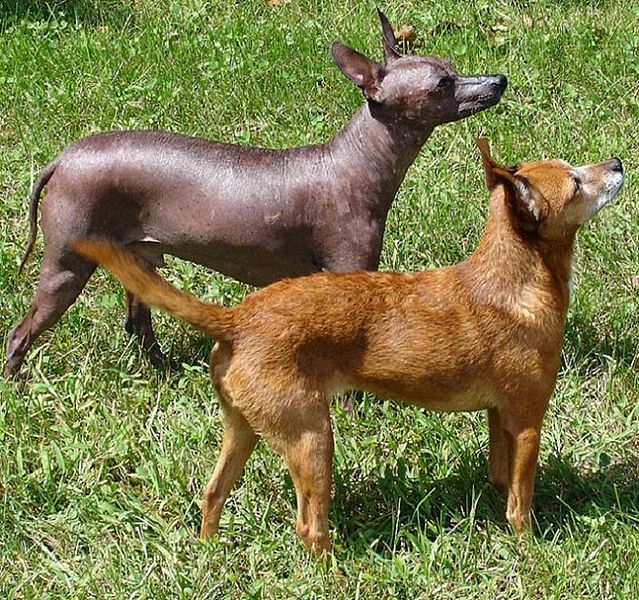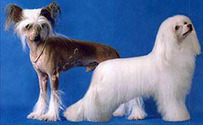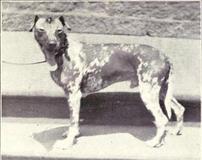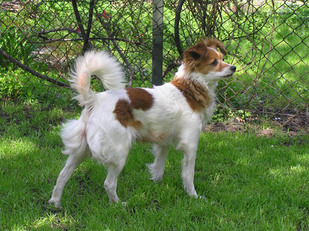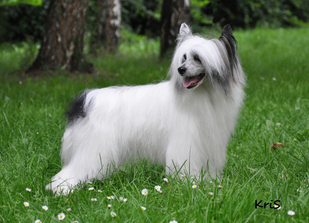The Lethal gene
The Genetic Mutation that Causes Hairless Dogs
by Linda Landon
Scientists have discovered a gene mutation that causes hairlessness in dogs. The discovery may help cure a genetic disease in humans. Dogs may truly be man's best friend.
A gene mutation causes hairlessness in dogs
Hairlessness results from a genetic mutation in the dog’s DNA. Scientists used DNA from Chinese Crested Dogs, to discover the mutated gene. Scientists discovered that the mutated gene was the blueprint for a protein that binds to DNA, which then controls the production of other proteins. The changes caused by the DNA mutation subsequently cause the dog to be hairless.
Hairless dogs also have bad teeth.
Hairless dogs also have problems with their teeth. Hairless dogs either have no teeth or their teeth are very weak. Most hairless dogs become toothless at some point in their lives. On the other hand, the coated hairless dogs (the one-fourth of hairless dogs that are born with hair) have strong, healthy teeth.
Hairless dogs must have one good copy of the gene to be born and survive.
Two copies of all genes are present in all dog and human cells. Generally, if one copy of a gene is mutated, the healthy copy will take its place. However, in the hairless gene, the healthy copy won’t replace the mutated copy. This means that dogs with one mutated and one healthy gene copy are hairless and dogs with two healthy gene copies have coats.
Pups with two mutated gene copies die before birth. This explains why breeders have not eliminated the coated variants of hairless breeds. All living hairless dogs must have one healthy gene copy to survive. The dogs must pass along the healthy gene in order for their offspring to survive.
A disease, ectodermal dysplasia, affects humans and dogs.
Since hairlessness and bad teeth always occur together and because at least one healthy copy of the gene is necessary for life, the scientists have concluded that the mutated gene plays an important role in the development of the body, which is most obviously seen in the hair and teeth. A human syndrome called ectodermal dysplasia causes people to have a condition very similar to that of hairless dogs.
Ectodermal dysplasia is a genetic disease caused by 150 different mutations in human DNA and occurs in both males and females of all races and ethnic groups. Children born with ectodermal dysplasia have malformed teeth and extremely sparse hair. The severity of the disease depends upon which mutation the child inherits.
Scientists seized the opportunity to study the similar mutation in dogs in order to gain understanding of the condition in humans. Knowledge gained from the dog might provide insights into how to cure or prevent ectodermal dysplasia. If this is true, dogs may be found to be a better “man’s best friend” than man ever knew.
References:
1. Dennis P. O'Brien, Gary S. Johnson, Robert D. Schnabel, Shahnawaz Khan, Joan R. Coates, Gayle C. Johnson, and Jeremy F. Taylor. Genetic Mapping of Canine Multiple System Degeneration and Ectodermal Dysplasia. Loci Journal of Heredity. (2005) Vol. 96. No. 7, 727-734. Website:http://jhered.oxfordjournals.org/cgi/reprint/96/7/727.
2. Cord Drögemüller, Elinor K. Karlsson, Marjo K. Hytönen, Michele Perloski, Gaudenz Dolf, Kirsi Sainio, Hannes Lohi, Kerstin Lindblad-Toh, Tosso Leeb. A Mutation in Hairless Dogs Implicates FOXI3 in Ectodermal Development. Science. (2008) Vol. 321. no. 5895, 1462. Website:http://www.ncbi.nlm.nih.gov/pubmed/18787161?ordinalpos=2&itool=EntrezSys...
A gene mutation causes hairlessness in dogs
Hairlessness results from a genetic mutation in the dog’s DNA. Scientists used DNA from Chinese Crested Dogs, to discover the mutated gene. Scientists discovered that the mutated gene was the blueprint for a protein that binds to DNA, which then controls the production of other proteins. The changes caused by the DNA mutation subsequently cause the dog to be hairless.
Hairless dogs also have bad teeth.
Hairless dogs also have problems with their teeth. Hairless dogs either have no teeth or their teeth are very weak. Most hairless dogs become toothless at some point in their lives. On the other hand, the coated hairless dogs (the one-fourth of hairless dogs that are born with hair) have strong, healthy teeth.
Hairless dogs must have one good copy of the gene to be born and survive.
Two copies of all genes are present in all dog and human cells. Generally, if one copy of a gene is mutated, the healthy copy will take its place. However, in the hairless gene, the healthy copy won’t replace the mutated copy. This means that dogs with one mutated and one healthy gene copy are hairless and dogs with two healthy gene copies have coats.
Pups with two mutated gene copies die before birth. This explains why breeders have not eliminated the coated variants of hairless breeds. All living hairless dogs must have one healthy gene copy to survive. The dogs must pass along the healthy gene in order for their offspring to survive.
A disease, ectodermal dysplasia, affects humans and dogs.
Since hairlessness and bad teeth always occur together and because at least one healthy copy of the gene is necessary for life, the scientists have concluded that the mutated gene plays an important role in the development of the body, which is most obviously seen in the hair and teeth. A human syndrome called ectodermal dysplasia causes people to have a condition very similar to that of hairless dogs.
Ectodermal dysplasia is a genetic disease caused by 150 different mutations in human DNA and occurs in both males and females of all races and ethnic groups. Children born with ectodermal dysplasia have malformed teeth and extremely sparse hair. The severity of the disease depends upon which mutation the child inherits.
Scientists seized the opportunity to study the similar mutation in dogs in order to gain understanding of the condition in humans. Knowledge gained from the dog might provide insights into how to cure or prevent ectodermal dysplasia. If this is true, dogs may be found to be a better “man’s best friend” than man ever knew.
References:
1. Dennis P. O'Brien, Gary S. Johnson, Robert D. Schnabel, Shahnawaz Khan, Joan R. Coates, Gayle C. Johnson, and Jeremy F. Taylor. Genetic Mapping of Canine Multiple System Degeneration and Ectodermal Dysplasia. Loci Journal of Heredity. (2005) Vol. 96. No. 7, 727-734. Website:http://jhered.oxfordjournals.org/cgi/reprint/96/7/727.
2. Cord Drögemüller, Elinor K. Karlsson, Marjo K. Hytönen, Michele Perloski, Gaudenz Dolf, Kirsi Sainio, Hannes Lohi, Kerstin Lindblad-Toh, Tosso Leeb. A Mutation in Hairless Dogs Implicates FOXI3 in Ectodermal Development. Science. (2008) Vol. 321. no. 5895, 1462. Website:http://www.ncbi.nlm.nih.gov/pubmed/18787161?ordinalpos=2&itool=EntrezSys...
There is now available DNA test for hairlessness for the chinese crested dog
Pictorial explanation of the mode of inheritance of the hairless gene
by Katarzyna Zienkiewicz RosaThea kennel
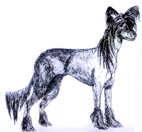
Heterozygous Hairless Crested carries the dominant gene for hairlessness (Hr) and the gene for a normal coat (hr). A lethal gene (Hr) is dominant over the recessive (hr). Thus the Heterozygous Hairless is referred to as (Hrhr).
Pic.©Katarzyna Zienkiewicz Hrhr
Pic.©Katarzyna Zienkiewicz Hrhr
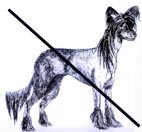
Homozygous Hairless Crested witch carries two copies of the hairless gene (HrHr) will not survive.
Pic.©Katarzyna Zienkiewicz HrhHr
Pic.©Katarzyna Zienkiewicz HrhHr
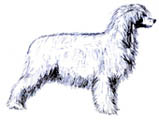
The Powder Puff doesn't carry the hairless (Hr)gene, only the gene for coat (hr), thus the Powder Puff is referred to as (hrhr). This combination is not lethal.
Pic.©Katarzyna Zienkiewicz hrhr
Pic.©Katarzyna Zienkiewicz hrhr
Breeding
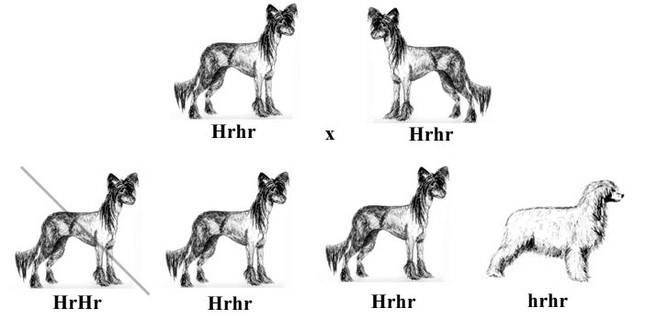
Pic.© Katarzyna Zienkiewicz
The mating of two Hairless (HrHr) x (HrHr) would result in the following probable combinations:
1 (HrHr) (25%) - Homozygous Hairless - Death, lethal genes;
2 (Hrhr) (50%) - Heterozygous Hairlesses
3 (hrhr) (25%) - Homozygous Powder Puff
Thus this mating could produce all Hairlesses (Hrhr) or all Powder Puffs (hrhr) or any combination.
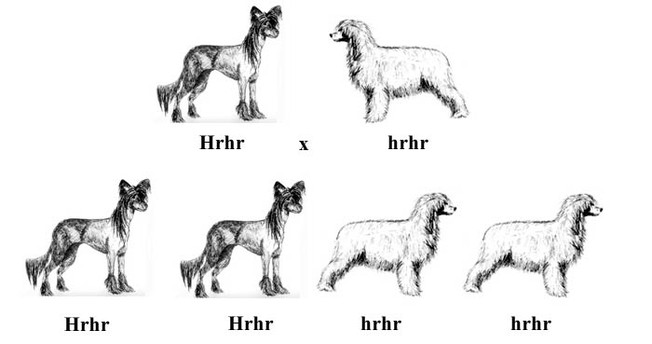
Pic.© Katarzyna Zienkiewicz
Mating a Hairless (Hrhr) to a Powder Puff (hrhr) would net the following avarage results:
1. (Hrhr) (50%) - Heterozygous Hairlesses
2. (hrhr) (50%) - Homozygous Powder Puffs
But this mating could produce all Hairlesses (Hrhr) or all Powder Puffs (hrhr) or any combination.
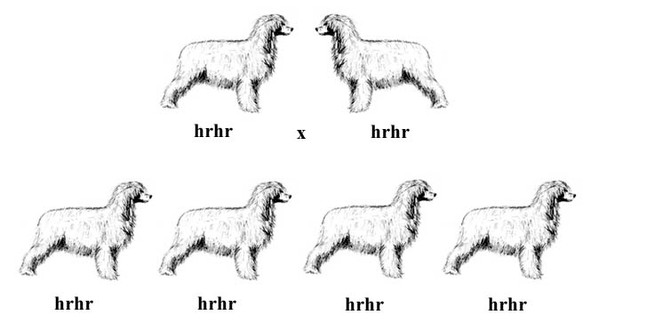
Pic.© Katarzyna Zienkiewicz
A Combination of Powder Puff (hrhr) to a Powder Puff (hrhr) will have a result of:
(100%) - Homozygous Powder Puffs
Current research of expression of hairlessness
A team of European scientists, led by Tosso Leeb of the University of Berne in Switzerland, had been searching for years for the genetic roots of the Chinese crested’s hairlessness and its abnormal dentition.
Recent research has finally revealed that the hairless mutation results from the insertion of seven letters of genetic code, named FOXI3, into a gene on chromosome 17. This error turns a coated dog into a hairless. Analysis of DNA samples from 140 hairless dogs (Xolos, Peruvian Inca Orchids and Chinese Cresteds) and 87 coated dogs confirmed that every coated dog in the study lacked the mutation, and every hairless dog possessed one copy. Researchers were unable to find a single instance of a matched pair of genes containing this seven letter DNA duplication.
Genetic test for hairlessness is now available... Due to this test they can now find out wether a dog is a puff or a hairless, no more doubting !
But they want to take it further, they want to find out which genes are responsible for the amount of hair in our dogs. Why for example when we breed two true hairless, we still get hairy hairless in the litter.
"In the course of our research we are also looking for genetic factors influencing the amount of residual hair on hairless dogs. There are so-called true hairless dogs with very little or no hair and also hairless dogs with a substantial amount of residual body hair (sometimes termed "semi-coated). If you own a hairless dog and are willing to contribute to our research, please contact us."
For that Theresa-Bernadette Mausberg at the University in Bern needs more bloodsamples. This is her contact address:
Theresa-Bernadette Mausberg
Vetsuisse Fakultät Universität Bern
Institut für Genetik
Bremgartenstr. 109a
3001 Bern
[email protected]
http://www.genetics.unibe.ch/content/e2353/e2814/index_eng.html
Recent research has finally revealed that the hairless mutation results from the insertion of seven letters of genetic code, named FOXI3, into a gene on chromosome 17. This error turns a coated dog into a hairless. Analysis of DNA samples from 140 hairless dogs (Xolos, Peruvian Inca Orchids and Chinese Cresteds) and 87 coated dogs confirmed that every coated dog in the study lacked the mutation, and every hairless dog possessed one copy. Researchers were unable to find a single instance of a matched pair of genes containing this seven letter DNA duplication.
Genetic test for hairlessness is now available... Due to this test they can now find out wether a dog is a puff or a hairless, no more doubting !
But they want to take it further, they want to find out which genes are responsible for the amount of hair in our dogs. Why for example when we breed two true hairless, we still get hairy hairless in the litter.
"In the course of our research we are also looking for genetic factors influencing the amount of residual hair on hairless dogs. There are so-called true hairless dogs with very little or no hair and also hairless dogs with a substantial amount of residual body hair (sometimes termed "semi-coated). If you own a hairless dog and are willing to contribute to our research, please contact us."
For that Theresa-Bernadette Mausberg at the University in Bern needs more bloodsamples. This is her contact address:
Theresa-Bernadette Mausberg
Vetsuisse Fakultät Universität Bern
Institut für Genetik
Bremgartenstr. 109a
3001 Bern
[email protected]
http://www.genetics.unibe.ch/content/e2353/e2814/index_eng.html
Furnished Coat & genetic test
A mutation responsible for 'furnishings' or 'satin' coat in dogs has recently been identified in the RSPO2 gene. Furnishings refer to the variation of longer facial hair seen in all wire haired breeds as well as some others. This finding was the result of an extensive collaborative effort by researchers from a number of universities and the National Human Genome Research Institute (NIH). The work was published by Cadieu et al. in the journal, Science (www.sciencexpress.org/27August 2009/Page2/10.1126/science.1177808), and the test offered here is based on that work. The mutation is dominant, so in breeds where the coat can vary, it is possible for a furnished dog to carry the 'unfurnished' trait (called satin by some).
http://www.vetgen.com/canine-furnished-coat.html
http://www.vetgen.com/canine-furnished-coat.html
INBREEDING CALCULATOR & THEORY
Copyright © 2004-2012 Katarzyna Zienkiewicz - Rosa Thea Kennel
